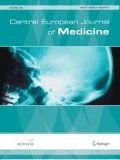Abstract
The most specific criterion for diagnosing neurosyphilis is a reactive CSF VDRL. Unfortunately, there are in Europe, including Poland small number of specialized laboratories for serological diagnosis of syphilis. Thus, CSF serology results are obtained with delay. Therefore, the decision on recommended therapy for neurosyphilis is taken on the basis of CSF basic tests. In this paper we attempt to determine the utility of CSF glucose concentration and its cut-off values in prediction of asymptomatic neurosyphilis. CSF and blood were collected from 55 HIV-uninfected patients with syphilis of unknown duration. Patients with neurosyphilis (14.5%) were characterized by higher CSF pleocytosis (p<0.0001), elevated CSF protein concentration (p<0.05) and lower CSF glucose concentration (p<0.0001). Multivariate regression analysis identified CSF pleocytosis and CSF glucose concentration as the two independent predictors of reactive CSF VDRL (p<0.0001). In the selected group of patients with CSF pleocytosis ≥5/µL (n=25) CSF glucose concentration ≤2.72 mmol/L was associated with 100% sensitivity (95%CI: 63–100%) and 100% specificity (95%CI: 75.3–100%) for reactive CSF VDRL. CSF glucose concentration may be particularly useful as a predictive marker of neurosyphilis in HIV uninfected patients with syphilis of unknown duration with CSF plecytosis ≥5/µL.
Similar content being viewed by others
References
Marra MC, Maxwell CL, Tantalo LC et al. Normalization of serum rapid plasma regain titers predicts normalization of cerebrospinal fluid and clinical abnormalities after treatment of neurosyphilis. CID. 2008; 47: 893–899
Lukehart SA, Hook EW 3rd, Baker-Zander SA et al. Invasion of the central nervous system by Treponema pallidum: implications for diagnosis and treatment. Ann Intern Med. 1988; 109: 855–862
Golden R, Marra CM, Holmes KK. Update on syphilis: resurgence of an old problem. JAMA. 2003; 290: 1510–1514
Wharton M, Chorba TL, Vogt RL, et al.: Case definitions for public health surveillance. MMWR Recomm Rep 1990, 39: 1–43
Moore JE, Hopkins H. Asymptomatic neurosyphilis. VI The prognosis of early and late asymptomatic neurosyphilis. JAMA. 1930; 95: 1637–1641
Goh BT, van Voorst Vader PC. European guideline for the management of syphilis. Int J STD AIDS. 2001; 12: 14–27
Marra CM. Déjà vu all over again: When to perform a lumbar puncture in HIV-infected patients with syphilis. Sex Transm Dis. 2007; 34: 145–146
Marra CM, Maxwell CL, Smith SL et al. Cerebrospinal fluid abnormalities in patients with syphilis: association with clinical and laboratory features. JID. 2004; 189: 369–376
Ghanem KG. Neurosyphilis: A historical perspective and review. CNS Neurosc Ther. 2010; 16: e157–e168
Ropper AH, Samuels MA. Chapter 2. Special Techniques for Neurologic Diagnosis (Chapter). Ropper AH, Samuels MA: Adams and Victor’s Principles of Neurology, 9e. Available at: http://www.accessmedicine.com/content.aspx?aID=3630099. Accessed July 8, 2011
Larsen SA, Stiener BM, Rudolph AL. Laboratory diagnosis and interpretation of tests for syphilis. Clin Microbiol Rev. 1995; 8: 1–21
Sexually Transmitted Diseases Treatment Guidelines 2002; Centres for Disease Control and Prevention. MMWR Recomm Rep. 2001; 51: 1–78
Mcgeeney T, Yount F, Hinthorn DR, Liu C. Utility of the FTA-ABS test of cerebrospinal-fluid in the diagnosis of neurosyphilis. Sex Transm Dis. 1979; 6: 195–198
Chauhan M, Serisha B, Sankar KN et al. Audit of the use of benzathine penicillin, post-treatment syphilis serology and partner notification of patients with early infectious syphilis. Int J STD AIDS 2006; 17: 200–202
Author information
Authors and Affiliations
Corresponding author
About this article
Cite this article
Pastuszczak, M., Wojas-Pelc, A. & Jaworek, A.K. Association of CSF glucose concentration with neurosyphilis diagnosis. cent.eur.j.med 8, 48–51 (2013). https://doi.org/10.2478/s11536-012-0060-6
Received:
Accepted:
Published:
Issue Date:
DOI: https://doi.org/10.2478/s11536-012-0060-6




